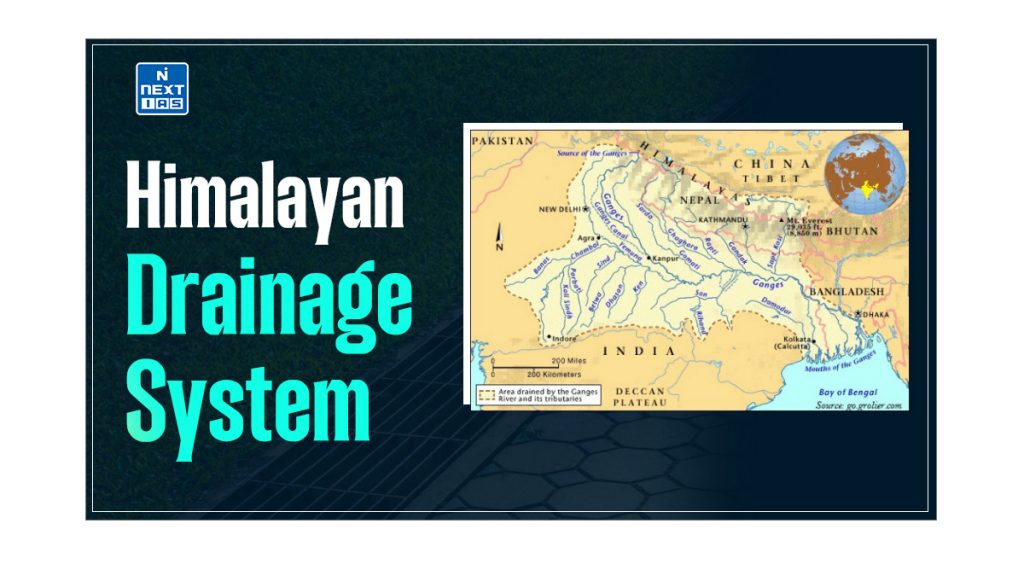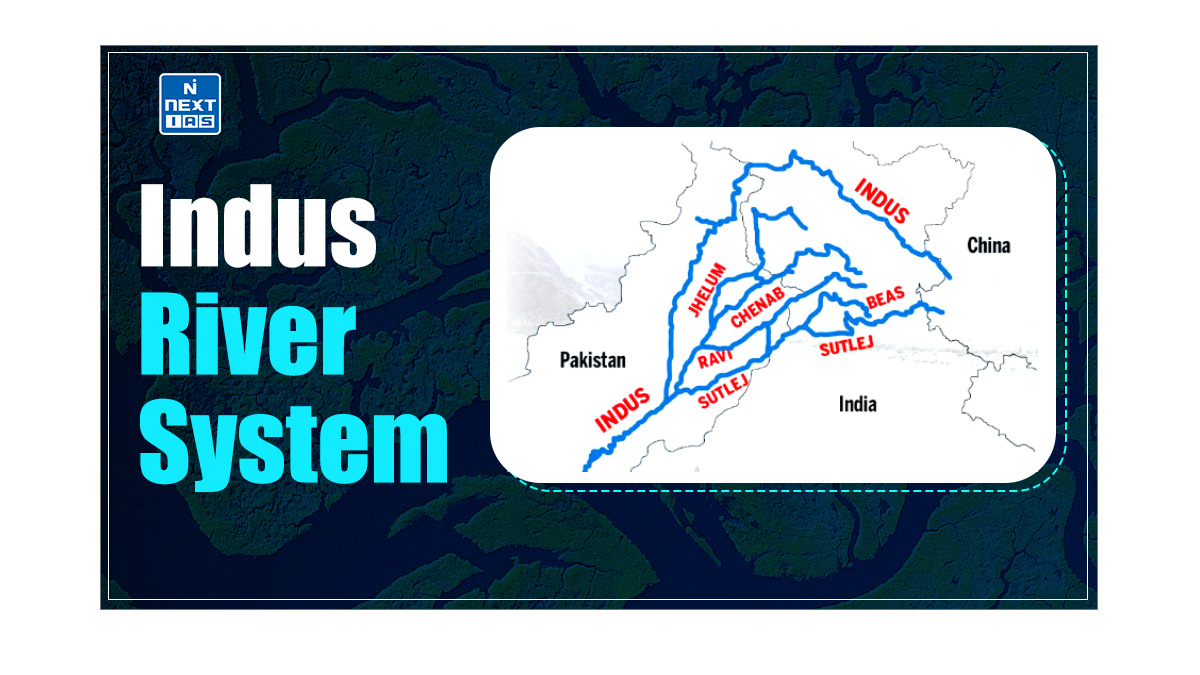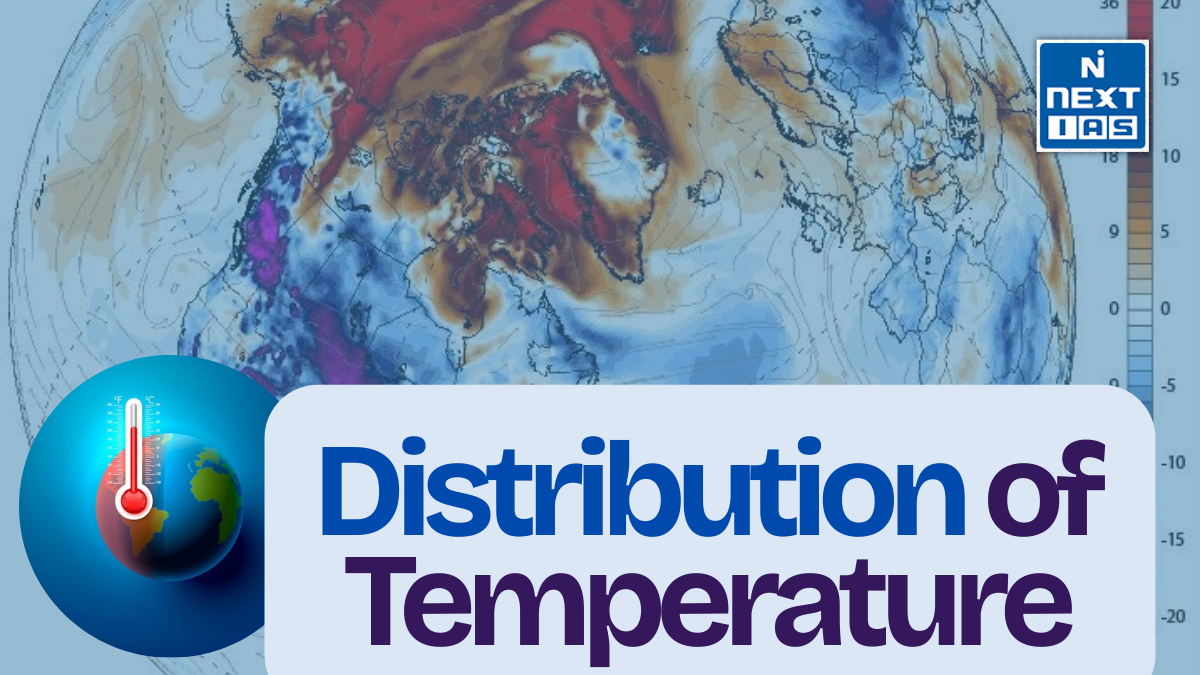
The Himalayan Drainage System is one of the most extensive and vital drainage systems on the planet. This intricate network of rivers, originating from the glaciers and snowfields of the Himalayas, has played a pivotal role in shaping the geography, ecology, and socio-economic fabric of the Indian subcontinent. This article aims to study in detail the Himalayan Drainage System, its evolution, major river systems, and other related aspects.
About Himalayan Drainage System
- The Himalayan River System mainly comprises the Indus, the Ganga, and the Brahmaputra river basins.
- These rivers are fed both by the melting of snow and precipitation.
- Therefore, rivers of this system are perennial.
- These pass through the giant gorges carved out by the erosional activities carried on simultaneously with the uplift of the Himalayas.
- Besides deep gorges, these rivers also form U-shaped valleys, V-shaped valleys, rapids and waterfalls in their mountainous course.
- In plains, they form depositional features like flat valleys, meanders, ox-bow lakes, flood plains, braided channels, and deltas near the river mouth.
- In the Himalayan regions, the course of these rivers is highly tortuous, but over the plains, they display a strong meandering tendency and shift their courses frequently.
- The course of the Kosi River is unstable and prone to significant erosion, which ultimately increases the sediment load in its flow. So, due to this increase in sediments, Kosi frequently changes its course.
- Also, Kosi which is known as the ‘Sorrow of Bihar’.
Evolution of Himalayan Drainage System
There are differences of opinion about the evolution of the Himalayan rivers:
- Geologists believe that a significant river, known as the Shiwalik or Indo-Brahma, once traversed the entire length of the Himalayas, extending from Assam to Punjab, and onward to Sindh, eventually discharging into the Gulf of Sindh near lower Punjab during the Miocene period, approximately 5-24 million years ago.
- The continuous stretch of the Shiwalik, combined with its lacustrine origin and alluvial deposits of sand, silt, clay, boulders, and conglomerates, supports this theory.
- Over time, the Indo-Brahma River is thought to have been divided into three main drainage systems:
- The Indus and its five tributaries in the Western part.
- The Ganga and its Himalayan tributaries are in the Central part.
- The Brahmaputra in Assam and its Himalayan tributaries in the Eastern part.
- This dismemberment likely occurred due to the Pleistocene upheaval in the western Himalayas, including the uplift of the Potwar Plateau (Delhi Ridge), which created a water divide between the Indus and Ganga drainage systems.
- Similarly, the downward thrusting of the Malda gap area between the Rajmahal hills and the Meghalaya plateau during the mid-Pleistocene period redirected the Ganga and Brahmaputra systems to flow towards the Bay of Bengal.
Features of Himalayan River System
The key features of the Himalayan River System are:
- Young Drainage Pattern – Himalayan rivers are relatively young and exhibit a dendritic or trellis drainage pattern characterized by numerous tributaries joining the main river.
- Seasonal Flow – These rivers are fed primarily by snowmelt from the Himalayan glaciers and experience significant variations in water flow throughout the year, with peak flows during the summer due to snowmelt and monsoon rains.
- Steep Gradients and V-Shaped Valleys – Himalayan rivers have steep gradients due to their origin in high-altitude regions, resulting in V-shaped valleys and rapid flow rates.
- Meandering Courses and Oxbow Lakes – Unlike Peninsular rivers, Himalayan rivers exhibit meandering courses, forming oxbow lakes, floodplains, and braided channels in lower reaches.
- Sediment-laden Rivers – Due to their steep gradients and erosive power, Himalayan rivers carry large amounts of sediment downstream, depositing them in the plains and creating fertile alluvial soils in regions like the Indo-Gangetic plain.
| Note: Major Himalayan drainage systems are the Indus, the Ganga and the Brahmaputra rivers. |
All these major river systems have been discussed in the section that follows.
Indus River System
- It originates from a glacier near Bokhar Chu in the Tibetan region in the Kailash Mountain Range near the Mansarovar Lake.
- The river flows northwest and enters the Ladakh region of India at a place called Demchok.
- After entering India, the Indus River flows in between the Karakoram and Ladakh ranges.
- In Tibet, it is known as ‘Singi Khamban or the Lion’s Mouth’.
Read our detailed article on the Indus River System.
Ganga River System
- The holy river Ganga is a major river of the Indian subcontinent rising in the Himalayan mountains and flowing about 2,525 km generally eastward through a vast plain to the Bay of Bengal.
- Flowing through a vast length, it crosses five states of India namely:
- Uttarakhand,
- Uttar Pradesh,
- Bihar,
- Jharkhand, and
- West Bengal.
- It has a catchment area of 8,61,404 sq. km (26.4%) of India.
- Major tributaries of River Ganga are:
- Yamuna,
- Ramganga,
- Gomti,
- Ghaghara,
- Gandak,
- Damodar, and
- Kosi etc.
Read our detailed article on the Ganga River System.
Yamuna River System
- It originates from the Yamunotri Glacier near Bandarpoonch Peak in the Mussoorie range of the Lower Himalayas.
- The Yamuna River flows through the states of Uttarakhand, Himachal Pradesh, and Haryana, then enters Delhi and merges with the Ganga near Triveni Sangam in Allahabad (Prayagraj).
| Note: The Yamuna River is the largest tributary of the Ganga in the northern plains. |
Read our detailed article on the Yamuna River System.
Brahmaputra River System
- The Brahmaputra (meaning the Son of Brahma) rises in the Chemayungdung glacier in southwestern Tibet.
- Its source is very close to the sources of Indus and Satluj.
- In spite of the exceptionally high altitude, the Tsangpo has a gentle slope.
- The river flows slowly and features a wide, navigable channel for approximately 640 kilometers.
Read our detailed article on the Brahmaputra River System.
Significance of Himalayan Drainage System
The Himalayan drainage system is of immense significance to the Indian subcontinent for several reasons:
- Water Supply – The rivers originating from the Himalayas, such as the Ganges, Brahmaputra, and Indus, provide a crucial water supply for drinking, irrigation, and industrial purposes.
- These rivers are perennial, fed by both monsoon rains and glacial melt, ensuring a continuous flow of water throughout the year.
- Agriculture – The fertile alluvial plains formed by the Himalayan rivers support extensive agricultural activities.
- Regions like the Indo -Gangetic Plain are among the most productive agricultural areas in the world, supporting crops such as rice, wheat, sugarcane, and various vegetables.
- Hydroelectric Power – The steep gradients and abundant water flow of Himalayan rivers make them ideal for hydroelectric power generation.
- Numerous dams and hydroelectric projects have been established to harness this potential, contributing significantly to the energy needs of the region.
- Biodiversity and Ecosystems – The diverse ecosystems supported by the Himalayan drainage system include a wide range of flora and fauna.
- These river basins host various species of fish, birds, and other wildlife, playing a crucial role in maintaining ecological balance.
- Cultural and Religious Importance – Many rivers originating from the Himalayas hold profound cultural and religious significance for the people of India and neighbouring countries.
- For instance, the Ganges River is considered sacred in Hinduism, and millions of pilgrims visit its banks for spiritual rituals and ceremonies.
- Economic Activities – The Himalayan rivers support numerous economic activities, including fishing, tourism, and transportation.
- The river valleys are home to many communities whose livelihoods depend on these water bodies.
- Climate Regulation – The Himalayas and their river systems influence the climate of the Indian subcontinent.
- They act as a barrier to cold winds from Central Asia, contributing to the relatively warmer climate of the region.
- Sediment Transport and Soil Fertility – The rivers of the Himalayan drainage system transport large amounts of sediments, which are deposited in the plains, enriching the soil and making it highly fertile.
- This sediment transport also helps in building deltas and replenishing coastal ecosystems.
Conclusion
The Himalayan drainage system, despite its immense contribution, faces formidable challenges. Climate change-induced glacial retreat poses a threat to the long-term water flow of these rivers, while pollution from human activities further jeopardizes water quality. Sustainable management practices are crucial for the future of these vital waterways. Conservation efforts aimed at protecting glaciers and promoting responsible water usage are essential to ensure that these mighty rivers continue to nourish the land and its people for generations to come.
Frequently Asked Questions (FAQs)
What is the drainage system of the Himalayan?
The drainage system of the Himalayas consists of major rivers like the Indus, Ganges, and Brahmaputra, which originate from the glaciers and high-altitude regions of the Himalayas.
What are the four features of the Himalayan river system?
The Himalayan river system features perennial flow from glacial melt and monsoon rains, deep V-shaped gorges, antecedent drainage patterns maintaining original courses despite rising terrain, and high sediment transport creating fertile plains and large deltas.
Which major river systems are included in Himalayan drainage?
The major river systems included in the Himalayan drainage are the Indus, Ganges, and Brahmaputra. These rivers, along with their extensive tributaries, originate in the Himalayas and flow across northern India, Nepal, Bhutan, and Bangladesh, playing a crucial role in the region’s hydrology and ecology.






